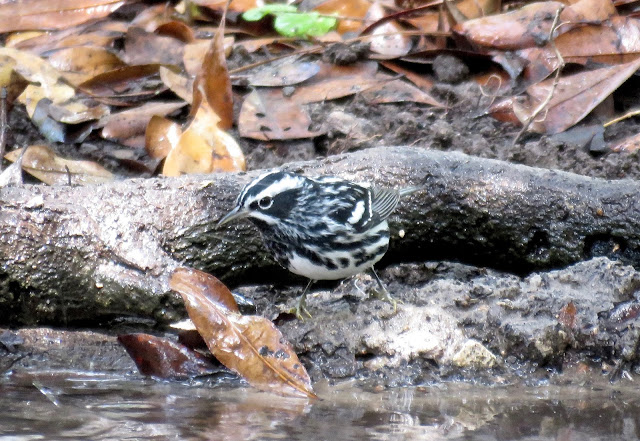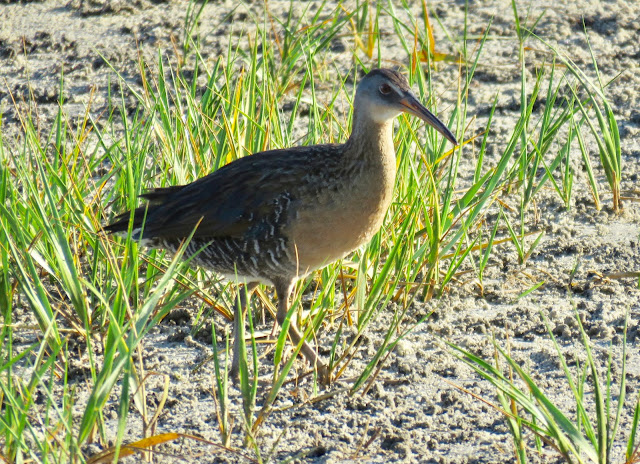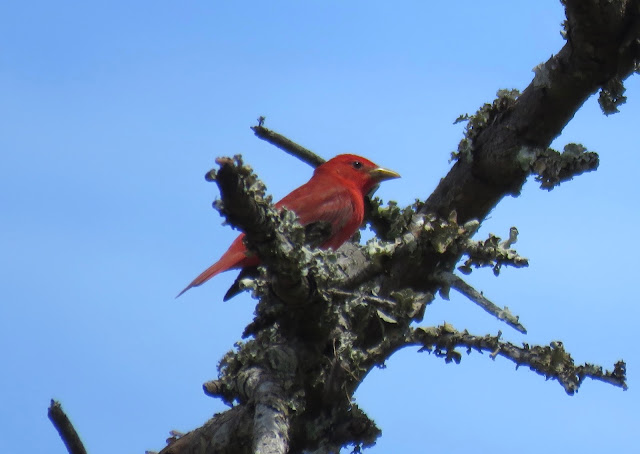Look up in that tree. It's a White-winged Dove!
Back at the puddle, a Northern Cardinal is sure enjoying a refreshing dip.
April is that wonderful time when summer residents are arriving, migrants are passing through, and some winter residents are still hanging around. This American Goldfinch was waiting for his spectacular breeding plumage to come in before heading north. I'd say he's looking mighty good!
Of course it's easy to look spectacular when you're all decked out in your gold and black breeding finery, but some of us think charcoal gray is wonderfully sleek and elegant. This Gray Catbird is ready to travel to his home, perhaps in upstate New York or somewhere in southern Canada.
Finally, on April 20, I welcomed the chance to make my way toward Cedar Key with about 18 others in my Third Thursday crew. We started out at Shell Mound where we had two delightful surprises awaiting us. When we first arrived I told the group that we should try for Clapper Rail. "Watch the tall grass along the boardwalk really carefully," I said. "Maybe we'll get lucky and see a Clapper sneak past us." I took out my phone and played a rail song ... and got an immediate answer from directly behind me. There was a Clapper Rail - not sneaking by - but right out in the open, blithely ignoring us while hunting in the short grass near the water's edge. He posed for us for five or six minutes while we chatted, oohed, and ahhed just twenty or thirty feet away.
So while we were standing there watching the Clapper, I guess we aroused the curiosity of at least one other traveler. Suddenly someone in the group called out for us to be still and look on the railing to our left. There, nestled among us, was a Barn Swallow, perhaps newly arrived from a long migratory journey and looking for a place to rest. It sat there for a minute or two, flew off a short distance when we began to move again, but came back to the same spot to rest for a few more minutes. My friend Jerry Pruitt got this photo, which I think is priceless and I use it here with Jerry's permission.
 |
| Barn Swallow at Shell Mound. Photo by Jerry Pruitt. |
Jerry is a great guy, and very humble, so I'll do a bit of bragging for him. He is a hell of a photographer. Shots like the one above are nothing unusual for him. In fact, I have another example of his work below, again used with his permission. We saw this Gray Kingbird on a wire in Cedar Key. I took a bunch of photos of this same bird, and none of mine turned out well. But Jerry got this one:
 |
| Gray Kingbird in Cedar Key. Photo by Jerry Pruitt |
We had a great day kicking around Cedar Key. At the cemetery we found this beautiful Great Crested Flycatcher.
But the best stop of the day was at the museum. There we found Cape May, Blackpoll, and Worm-eating Warblers as well as the star of the day - this gorgeous Red-breasted Nuthatch. It was only the second time I've seen one this far south. It scrambled from branch to branch just above our heads for a good long while. Its constant movement made it a challenge to get everyone on it, but it was well worth the effort. For many in the group it was a life bird - a reason for celebration for all of us.
Meanwhile, back in Gainesville, Matt Bruce and Rex Rowan were kayaking on Newnan's Lake, looking for something unusual. Did they ever find it! The recent drought has been severe. About the only benefit to the increasingly shallow water of the lake is that in past droughts it has attracted several rarities. This year would prove the rule. In the southeast corner of the lake, where Prairie Creek flows into it, they found a mixed flock of shorebirds. Among them was a striking bird that was darker than the rest. It was a Ruff! This is a seriously rare bird for central Florida. I've only seen one other and its plumage was pale and almost featureless. Not so with this bird! Fortunately, it stayed in that spot for the better part of a week. The location was ideal for us landlubbers. The fishing pier at nearby Powers Park afforded a great spot from which to observe the bird. A scope was needed to get a really satisfying view, but the bird could be picked out of the crowd of other shorebirds with a good set of binoculars. I got to Powers in the early afternoon of the 24th, and a group of other birders was already there. I have a great scope, so I checked out the bird and then stood aside while some local grad students from the University of Florida picked up their lifer. The distance was too great for me to get a usable photo, but the generosity of others filled the void. The photo below was provided by local nature photographer Glenn Price and is used here with his permission.
 |
| Ruff at Newnan's Lake. Photo by Glenn Price. |
A day later the Facebook page dedicated to Florida birding got lit up with word of a fallout in the Fort DeSoto area. It was already getting late in the morning, so a four and a half hour trip south to get there wasn't in the cards. However, if there were birds dropping in at Fort DeSoto, maybe they were moving into Cedar Key as well. We piled into the Big Red Van and ninety minutes later we were looking at some terrific birds. I drove directly to the museum grounds, thinking that it had been a hotspot a week earlier, so why not start there? It was a good call, but it started slowly. At first, the only birds we saw were a couple of Indigo Buntings playing in a birdbath and grazing along the ground. This one still hadn't reached the fantastic electric blue of the breeding plumage, but he was getting there.
However, within seconds even the Buntings were gone. Nothing was moving at all. Then I looked to my right, at eye level about 15 yards away. There sat a Barred Owl, very much awake and active at noon! It paid me no attention while I snapped multiple photos, and only left the area when it realized there was nothing to hunt.
Once the owl left, the other birds came out to eat and play. Among them was my "first of the year" Swainson's Thrush. In fact, we saw about a half dozen of them scattered around Cedar Key that day. This one wasn't camera shy at all.
After leaving the museum grounds, we decided to walk around a nearby neighborhood that has been productive in the past. This time it produced another real beauty, a female Scarlet Tanager! Here she is.
The bird world is filled with wonders, not the least of which is the differences between male and female of the same species. Generally, the male is the prettier, needing every bit of his good looks to attract a female in the hopes of starting a family. Prettier is one thing, completely different if quite another. The male and female Red-winged Blackbirds don't look at all alike. And the Scarlet Tanager is another example. While the female is the lovely yellow and olive pictured above, the male is quite different:
That scarlet and black is breathtaking! We saw this handsome guy near the Episcopal Church on Fifth Street.
Not to be outdone by his Scarlet cousins, this male Summer Tanager made an appearance early in the afternoon.
We also had a little luck at the cemetery. John Hintermister and Pat Burns helped me see a Blue Grosbeak, but it escaped before I could grab my camera. We returned the favor by getting them on a Rose-breasted Grosbeak. It played hide and seek among the leaves, so this is the best photo I could get.
April was proving to be a bountiful month, and it held one last treasure waiting to be discovered. On the 26th I led my monthly bird walk at Sweetwater Wetlands Park in Gainesville. I've shared dozens of photos from there in the past, but this day held one very special bird. Near the end of the walk we found a small flock of Bobolinks. It was a long distance for a photo, but it turned out fairly well.
So April drew to a close. It was a wonderful month, filled with colorful migrants and a couple of local rarities. For the month, I only had 83 species in Alachua County, but a total of 132 overall. My year totals were getting a little more respectable. My county total had reached 141, and my state total stood at 197, both decent numbers for someone not chasing a big year.
In closing, here's a bonus photo for you butterfly lovers. While standing on the pier watching the Ruff, a Red Admiral landed right next to my shoe and spread its wings displaying its stunning good looks for all the world to see. The world continued to stare at the Ruff, but I stepped back, took my camera out, and snapped the photo below.

















Another bird extravaganza! With a butterfly bonus! I apparently just missed a Ruff visiting the Circle B Bar Reserve but I'm happy you found one. That Red-breasted Nuthatch would certainly make my day!
ReplyDeleteWonderful reporting, Bob, and thank you for sharing so many great images!